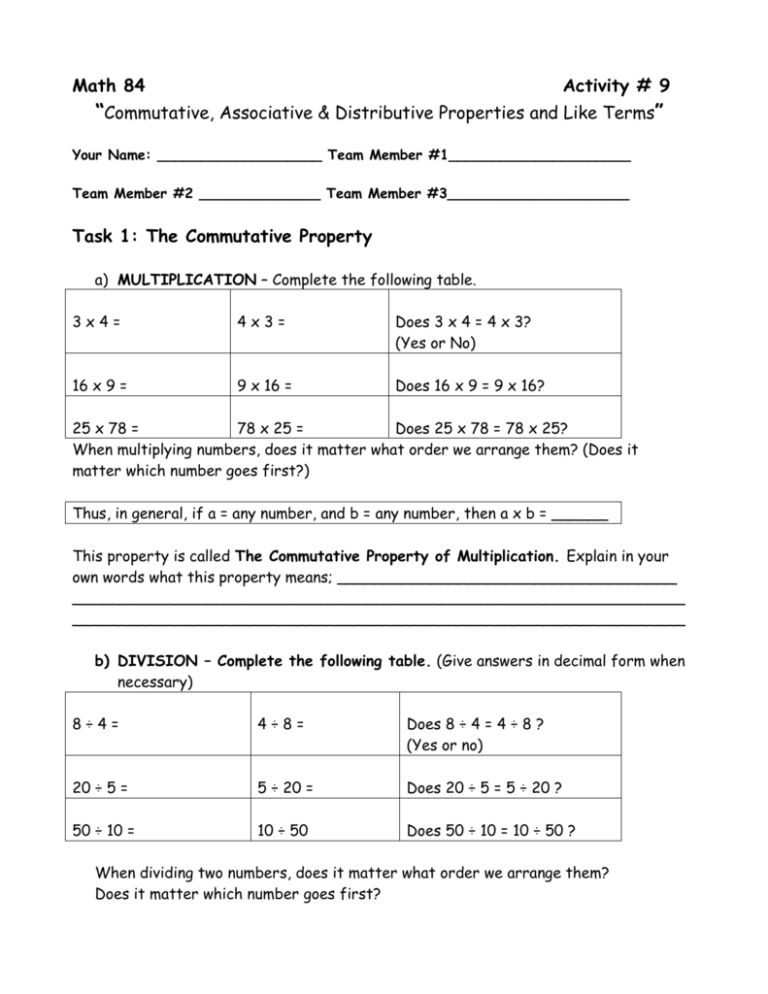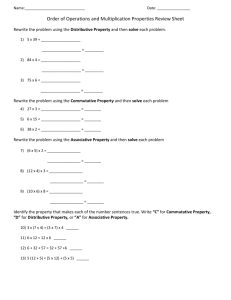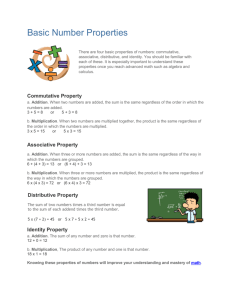Math- 84 - smcdevmath
advertisement

Math 84 Activity # 9 “Commutative, Associative & Distributive Properties and Like Terms” Your Name: ___________________ Team Member #1_____________________ Team Member #2 ______________ Team Member #3_____________________ Task 1: The Commutative Property a) MULTIPLICATION – Complete the following table. 3x4= 4x3= Does 3 x 4 = 4 x 3? (Yes or No) 16 x 9 = 9 x 16 = Does 16 x 9 = 9 x 16? 25 x 78 = 78 x 25 = Does 25 x 78 = 78 x 25? When multiplying numbers, does it matter what order we arrange them? (Does it matter which number goes first?) Thus, in general, if a = any number, and b = any number, then a x b = ______ This property is called The Commutative Property of Multiplication. Explain in your own words what this property means; ____________________________________ _________________________________________________________________ _________________________________________________________________ b) DIVISION – Complete the following table. (Give answers in decimal form when necessary) 8÷4= 4÷8= Does 8 ÷ 4 = 4 ÷ 8 ? (Yes or no) 20 ÷ 5 = 5 ÷ 20 = Does 20 ÷ 5 = 5 ÷ 20 ? 50 ÷ 10 = 10 ÷ 50 Does 50 ÷ 10 = 10 ÷ 50 ? When dividing two numbers, does it matter what order we arrange them? Does it matter which number goes first? Is Division commutative? (Why or why not ?) c) ADDITION – Complete the following table. 3+4= 4+3= Does 3 + 4 = 4 + 3 ? (Yes or No) 16 + 9 = 9 + 16 = Does 9 + 16 = 16 + 9? 25 + 78 = 78 + 25 = Does 25 + 78 = 78 + 25? When adding two numbers, does it matter what order we arrange them? Does it matter which number goes first? Thus in general, if a = any number, and b = any number, then a + b = _______ Is Addition commutative? (Why or Why not?) _________________________________________________________ d) SUBTRACTION – Complete the following table. 4–3= 3–4= Does 4 – 3 = 3 – 4 ? (Yes or No) 18 – 6 = 6 – 18 = Does 18 – 6 = 6 – 18 ? 75 – 29 = 29 – 75 = Does 75 – 29 = 29 – 75 ? When subtracting two numbers does it matter what order we arrange them? Does it matter which number goes first? Do we get the same answer no matter which number we put first? Is subtraction commutative? (Why or why not?) e) Out of the four basic operations, which are commutative? which are not commutative? Task 2: The Associative Property The Associative Property of Multiplication or Addition states that we can “group” numbers in any order when multiplying or adding and the answer will be the same. a) Example. Do what’s inside the parentheses first. (20 x 10) x 2 = ____ ? 20 x (10 x 2) = ____ ? b) Did you get the same result even though you used a different group first in each case? This is an example that shows multiplication is an associative operation. c) Complete the following to find out what other operations are associative. (20 – 10) – 2 = 20 – (10 – 2) = Is Subtraction Associative? (20 ÷ 10) ÷ 2 = 20 ÷ (10 ÷ 2) = Is Division Associative? 20 + (10 + 2) = Is Addition Associative? (20 + 10) + 2 = d) Show the Associative Property of Addition using the numbers 6, 5 and 2. e) Insert parentheses to illustrate The Associative Property of Multiplication: 8 x 3 x 7 = 8 x 3 x 7 The manner in which three numbers are grouped together under addition or multiplication does not affect the sum or product. Task 3: The Distributive Property The distributive property can be represented as such: a b c a b a c a) Complete the following table. Re-write Ex: 3 2 1 3 2 3 1 Re-write c. 8 2 5y a. d. b. e. 3a b 3c 4 3 2 5 2 15 3 2 x Task 4: Like Terms a) Organize the following terms into like term groupings into the boxes below. If the term has NO like terms, just underline it . -4x, 6xy, 3x²y, 21, -6y, 7x, 14x³, -x²y, -2xy, 2x³, 12x³y², 3xy, -5x³, 9 b) Simplify: Clear parentheses and combine like terms: -8(x-4), -5(x+9) c) Combine like terms: 4xy + 5 + 3x²-xy + 10 +x²+2xy³ d) Simplify 8x3 y 2 2 x 9 x 2 3 (2 x3 y 2 ) (5 x) y 2 2




